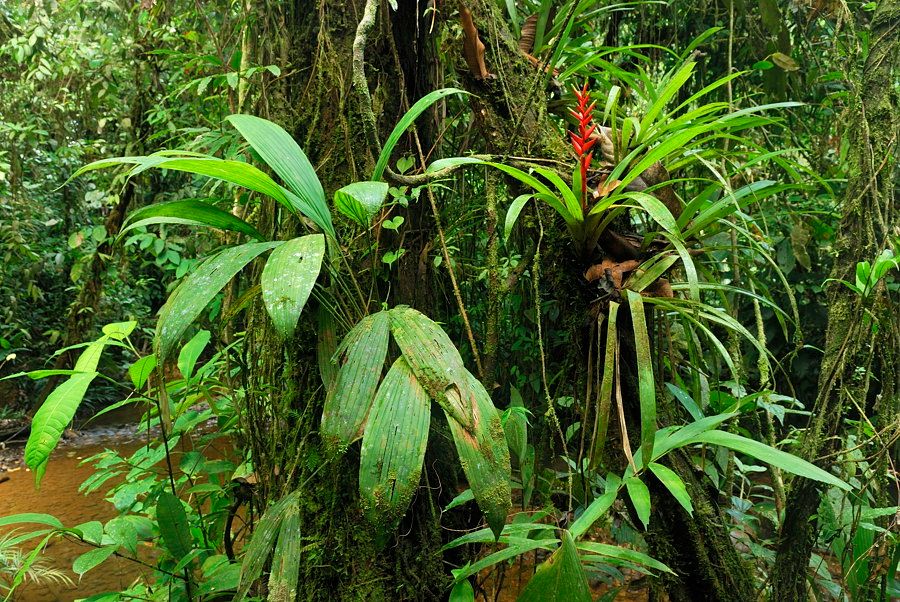Rainforests
The term "tropical rainforest" refers to all the evergreen forests of the tropics. These span the earth like a belt along the equator. Intense sunlight, constantly high temperatures and at least two thousand liters of rain per square meter per year create the greatest species richness on earth.
Types of tropical rainforests
The three large rainforest regions of the world (Amazonia in South America, the Congo Basin in Africa and Southeast Asia) are classified as permanently wet lowland rainforests. These are the tropical rainforests generally known in the classical sense. However, the term "tropical rainforest" also includes many other forests such as tropical dry forests, mountain rainforests, floodplain- and alluvial forests, as well as mangrove forests.
What are primary forests
Largely untouched forests are called primary forests. In these forests, the natural ecological processes run undisturbed. The tropical rainforests in the three large rainforest regions (Amazonia, Congo Basin and Southeast Asia) comprise more than half of all primary forests occurring worldwide. They are the most species-rich and diverse terrestrial ecosystems on earth.

Climate
Sun and rain, warmth and humidity - this characterises the climate in the rainforest. Temperatures are constant throughout the year at around 25°C. This creates an enormous evaporation force and consequently it rains a lot. Based on the amount of rainfall, the year in the tropics is divided into dry and rainy seasons. There are no classic seasons with spring, summer, autumn and winter as we know them.
Why does it rain so much in the rainforest?
The sun shines 12-14 hours a day and causes enormous evaporation. The evaporated water rises with the air, causing considerable cloud formation by the afternoon. At the latest in the evening hours it begins to rain very heavily. The rainforest itself supports this process, as the dense vegetation absorbs enormous amounts of water overnight, which is released again throughout the day.
In addition, the so-called trade winds regularly supply the tropical and subtropical areas along and around the equator with new moist air. Dry, warm air sucks in vaporized water from the oceans and is blown inland by the wind. The humid air evaporates through the sun's rays and thus increases cloud formation.
Species diversity and ecology
Half of all animal and plant species on earth live in the rainforest. One hectare of rainforest can house 42,000 species of insects and 1,500 species of plants, of which 750 are different tree species. By comparison, forests in temperate zones contain only 100 tree species per hectare. While the number of species in the rainforest is very large, the number of individuals of a species is rather small.
The fact that such a large number of species has evolved in the rainforests is due to the great age of these habitats (tropical rainforests have existed on earth for about 60 million years) and the stable, uniform climate of these forests.
In the many different ecological niches in the rainforest there is suitable habitat for many different animal and plant species. Light and nutrients are in short supply here. All inhabitants of the rainforest must therefore specialize. There are many climbing artists among plants, such as lianas and bindweeds. Many flowers and ferns grow on big trees to get more access to light. They absorb most of their required nutrients from the rainwater. Such plants are called epiphytes.
A key characteristic of the rainsforest ecosystem is the division of the vegetation into several well defined levels. The uppermost level consists of scattered, very large trees that can reach a height of 60 meters. Below this is the canopy formed by trees 15 to 45 meters high. The dense canopy of leaves allows very little sunlight to pass through to the ground. Therefore, mainly shade-loving species thrive on the forest floor.
Many plants remain as seeds or small seedlings until they are given a chance to grow - for example, when an old jungle giant falls and tears a hole in the dense canopy.
Many jungle trees have roots called buttress roots. They form on or just below the surface to better access the limited nutrients. The roots widen, like boards, towards the trunk, providing the tree with stability.
Although the breathtaking biodiversity of tropical rainforests could indicate very nutrient-rich soils, soils are surprisingly low in nutrients and almost infertile. That tropical rainforests are nevertheless among the most productive ecosystems in the world is due to perfect nutrient recycling: dead plants or dead animals are immediately decomposed by numerous organisms and thus returned to the nutrient cycle. Soils in the rainforest therefore have a very thin layer of humus.

Significance
Tropical rainforests encompass many different important aspects. On top of their species richness and their beauty they also fullfill a number of roles which are not just crucial to the inhabitants of the rainforests:
The rainforest is a huge pantry
A large proportion of all crop plants world wide are tropical origin, such as, for example bananas, cocoa or rubber plant.
The rainforest is an enormous pharmacy
More than a quarter of our prescription drugs have their origin in the tropics.
Rainforests are water reservoirs
They work like huge sponges that suck up rainwater and sweat it out through the leaves. They produce their own clouds and the regular cycle of evaporation provides vital precipitation in far-off arid regions.
Rainforests act as climate regulators
Tropical rainforests play an important role as "green lungs". They produce the oxygen that is essential for our survival. At the same time, they store large amounts of the greenhouse gas carbon dioxide and therefore help mitigate human-induced globale climate change. In total, rainforests store 260 gigatonnes of carbon dioxide. This accounts for two thirds of the carbon dioxide fixed in vegetation worldwide. By comparison: our native forests store barely 50 gigatonnes of carbon dioxide.
Rainforests are human habitat
For 60 million indigenous people, the rainforest is their home, their source of nutrition, medicine and housebuilding and a spiritual place. They are extremely dependent on the rainforest.
Rainforest destruction
Rainforests are disappearing at a staggering pace. More than half of the rainforests have already been lost to deforestation, other areas are heavily damaged or have been fragmented into little islands of forests. In 2018 12 million hectares of tropical forest disappeared. That's is the equivalent of 30 soccer pitches per minute falling victim to chainsaws, bulldozers and to slash and burn clearings.
Causes for the destruction of rainforest
The history of the destruction of tropical forests already began with the expeditions of discovery and conquest by European explorers. The discovery of precious metals such as gold, silver and diamonds, but also the importance of tropical spices and other tropical agricultural products led to the destruction of large areas of forest from an early stage. And the destruction of rainforests continues today.
Agriculture is now estimated to bear the main responsibility for forest destruction in the tropics, accounting for 85% of the total. Small farms are responsible for 20% of this, livestock farming for another 20% and agro-industry for 60%. Among other things, sugar cane, soy or oil palms are cultivated. Traditional migratory farming can still be described as an ecologically adapted economic method for tropical areas. The small-scale (fire) clearings become overgrown again relatively quickly after use. The replacement of migratory farming with industrial production systems (large-scale export-oriented monocultures and extensive cattle farming) often leads to the displacement of small farmers by larger landowners. The biggest expansion of agro-industry in tropical rainforests has been taking place for years in Indonesia and Malaysia, the two leading countries in palm oil production. In Indonesia, more than a quarter of the rainforest has been destroyed since 1990. Technical progress is facilitating the rapid and complete clearing of huge areas (clear cutting).
The felling of wood for the furniture and timber industry accounts for 10% of forest destruction in the tropics. Almost a third of the timber felled in the tropics is destined for export. A major problem is illegal logging, which is almost impossible to stop despite import regulations. In selective logging, only valuable trees (precious woods) are removed from the forest (1 to 2 logs per hectare). This leads to damage to the gene pool of a tree population. Subsequent tree generations are of significantly lower quality. On top of this, additional forest area is damaged by felling and transport.
Mining or infrastructure projects are responsible for 5% of tropical forest destruction. The exploitation of raw material deposits (e.g. oil, gold, copper), industrial processing facilities, large-scale infrastructure development programmes and the implementation of huge dam projects are some examples of this. Such projects are usually accompanied by other infrastructural constructions such as roads, power lines, pipelines, etc.
Global environmental destruction is primarily caused by economic processes and lifestyles in industrialized countries. Export revenues from the sale of forestry and agricultural products are an important source of foreign exchange for rainforest countries. The high level of dept of these countries increases the pressure to earn foreign exchange and thus often to sell off the natural resources of a country. The lack of, and often corrupt, governance in rainforest countries exacerbates the problem.
Consequences of rainforest destruction
The consequences of the destruction of rainforests are dramatic for humans, animals and plants in the rainforest - but also for us in our own countries.
Loss of biodiversity
With the destruction of the rainforest countless species go extinct. Each day more than 100 species are lost. Every interference in the ecosystem affects the balance of the plants and animals living together.
Global climate change
When rainforests are destroyed through slash and burn clearing or when peat soils are drained for agriculture use, huge amounts of carbon dioxid stored in these systems is released into the atmosphere. Furthermore, intense livestock farming and the flooding of large areas for huge dams releases the even more dangerous greenhouse gas methane. This leads to a positive feedback cycle that further intensifies the climat crisis.
Disturbed water cycle
Three-quarters of the water in the rainforest circulates constantly and is recycled by the forest. As a result of deforestation, the water simply drains away or seeps into the soil instead of being recycled. As a result, less moisture evaporates into the atmosphere and the rains fail. This causes droughts to occur, rivers to dry up and deserts to spread along the tropics.
Soil erosion
Where the forest is cleared, the rain washes away the thin, fragile, nutrient-rich layer of soil. What remains is barren soil, which is susceptible to erosion. This makes it very difficult to replant large bare areas with new rainforest. After a few years the soil can no longer sustain agriculture. As a consequence, new areas have to be cleared. On the nutrient-poor rainforest soil, profitable agriculture is anyway only possible with a lot of fertilizer.
Displacement of indigenous and local people
For thousands of years indigenous peoples have lived in and from the forest without destroying it. For the sake of agricultural production and extraction of raw materials, indigenous peoples are driven off their ancestral lands, losing their homes, food and spiritual places. Today, the survival of many indigenous peoples is threatened. These include the Awá Indians in Brazil, the Pygmies in Africa, the Penan in Malaysia and many others. In addition, millions of farmers are suffering from the destruction of the rainforest because they need intact forests to store water.
Loss of unexplored medical substances
Countless species are going extinct due to the destruction of the rainforest. As a consequence, medicines are lost that may be effective against numerous diseases. Many plant species with potential ingredients either won't be discovered or cannot be tested for their medicinal effects before they go extinct. Future generations will therefore not have the same opportunities to cure known and emerging diseases.
Reduction of food security
If the native variants of our crops become extinct or their genetic diversity is lost, we also lose the option to crossbreed potential resistance to newly emerging pests or climate-adapted traits (e.g. drought resistance) into our crops.


